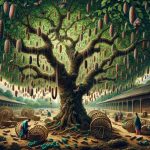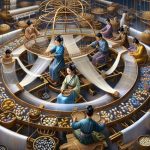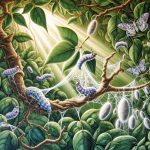Have you ever wondered what silk is made of and how it becomes fabric?
In this article, we’ll explore the fascinating process of silk production, from the history and role of silk worms to the natural properties of silk.
We’ll also delve into different types of silk fabric, including blends and alternative options.
Plus, we’ll discuss sustainable and ethical silk production, as well as share tips on how to care for and maintain your silk garments.
Get ready to unravel the secrets of silk!
Table of Contents
History of Silk Production
Silk’s history dates back to ancient China, where it was first produced and traded. The techniques used in silk production were a closely guarded secret for many centuries. Skilled artisans would carefully raise silkworms, feed them mulberry leaves, and collect the cocoons they spun. The cocoons were then boiled in hot water to loosen the silk fibers. The fibers were unwound, spun into threads, and woven into luxurious fabrics. The production of silk required great skill and attention to detail.
Silk became an important commodity, and its trade routes expanded across Asia, Europe, and Africa. The Silk Road, a network of trade routes, facilitated the exchange of silk and other goods between these regions. The Silk Road was not a single road but a series of interconnected routes that stretched for thousands of miles. Traders transported silk along these routes, opening up new markets and creating cultural and economic exchanges.
Silk production techniques and trade routes played a significant role in shaping the history of civilizations. The demand for silk led to the establishment of prosperous cities and the development of trade networks. The knowledge of silk production eventually spread beyond China, reaching other parts of the world. Today, silk continues to be highly valued for its softness, luster, and durability, carrying with it a rich history that spans centuries.
Silk Worms and Their Role
Did you know that silk worms play a crucial role in the production of this luxurious material? Silk worms, also known as Bombyx mori, are the larval stage of silk moths. They are responsible for spinning the silk thread that is used to create silk fabric. The life cycle of a silk worm consists of four stages: egg, larva, pupa, and adult.
Silk worm farming, also known as sericulture, is the process of raising silk worms for the production of silk. The process begins with the incubation of silk worm eggs. Once the eggs hatch, the larvae are fed a diet consisting mainly of mulberry leaves. They grow rapidly and molt several times before entering the pupal stage. During this stage, the silk worm spins a cocoon made of silk thread.
The silk thread is obtained by carefully unraveling the silk cocoons. The thread can be up to 900 meters long and is incredibly strong and flexible. Multiple silk threads are then combined to create a single silk thread that can be woven into fabric. The silk worm farming industry is prevalent in countries like China, India, and Japan, where the climate and resources are suitable for the production of silk.
Silk Production Process
In this discussion, you’ll learn about the fascinating process of silk production.
We’ll explore the world of sericulture, the art of raising silk worms and cultivating silk.
Additionally, we’ll delve into the various methods used to extract silk from the cocoons, unveiling the intricate techniques behind this luxurious fabric.
Sericulture and Silk Worms
You might be wondering how silk worms contribute to the production of this luxurious fabric. Well, sericulture techniques play a crucial role in the silk industry, and silk worms are at the heart of it all. Here’s how they make it happen:
- Silk worm eggs are carefully incubated and hatched into tiny larvae.
- These larvae are then fed a special diet of mulberry leaves to promote their growth.
- As they grow, the larvae spin silk threads around themselves to form cocoons.
- After about two weeks, the cocoons are carefully harvested and processed to extract the silk fibers.
These sericulture techniques have a significant impact on the silk industry, as they ensure the production of high-quality silk fabric. By understanding and nurturing silk worms, we can enjoy the beauty and luxury of silk in our lives.
Silk Extraction Methods
When extracting silk from cocoons, it’s important to gently unravel the threads without causing damage. Silk cultivation is a vital part of the silk industry, which has a long history dating back to ancient times.
The process of silk extraction involves carefully unwinding the cocoon to obtain the silk thread. This delicate process requires skill and precision to avoid breaking or tangling the threads. The cocoon is soaked in hot water to loosen the silk fibers before gently unraveling the thin, delicate strands.
These threads are then spun together to create the luxurious silk fabric that is highly valued for its smooth texture and lustrous appearance. Silk extraction is a meticulous process that plays a crucial role in the production of silk, contributing to the thriving silk industry.
Natural Properties of Silk
Silk’s natural properties make it a highly sought-after fabric. Its unique characteristics have been cherished for centuries, and its benefits and uses are numerous. Let’s take a closer look at some of the remarkable properties of silk:
| Property | Description |
|---|---|
| Softness | Silk is incredibly soft and smooth, providing a luxurious feel. |
| Breathability | Silk is highly breathable, allowing air to circulate and keeping you cool in hot weather. |
| Moisture-wicking | Silk has excellent moisture-wicking properties, keeping you dry and comfortable. |
| Hypoallergenic | Silk is naturally hypoallergenic, making it ideal for those with sensitive skin or allergies. |
| Strength | Despite its delicate appearance, silk is surprisingly strong and durable. |
The natural properties of silk make it a versatile fabric that can be used in various ways. Its softness and breathability make it perfect for clothing, especially in warm climates. Silk’s moisture-wicking abilities make it an excellent choice for activewear and sleepwear. Its hypoallergenic nature makes it suitable for bedding and pillows, ensuring a restful night’s sleep. Additionally, silk’s strength allows it to be used in other applications such as upholstery and drapes.
Types of Silk Fabric
When it comes to silk fabric, there are several key points to consider.
First, there is the debate between Mulberry silk and Wild silk. Mulberry silk is known for its superior quality, while Wild silk is more sustainable.
Second, we have Charmeuse silk and Dupioni silk. Charmeuse silk is smooth and shiny, while Dupioni silk has a more textured appearance.
Lastly, there is Habotai silk and Chiffon silk. Habotai silk is lightweight and smooth, while Chiffon is sheer and floaty.
These distinctions in silk fabric can help you choose the right one for your specific needs.
Mulberry Vs. Wild:
The main difference between mulberry silk and wild silk lies in the source of their production.
Mulberry silk comes from silkworms that are specifically bred in controlled environments, where they are fed only mulberry leaves. This type of silk is known for its fine texture, lustrous appearance, and high quality.
On the other hand, wild silk is derived from silkworms that are found in their natural habitats, such as forests and jungles. These silkworms feed on a variety of plants and produce a coarser and less uniform silk compared to mulberry silk.
Wild silk is often considered to have a more rustic and uneven texture, which some people prefer for its natural and unique characteristics.
Charmeuse Vs. Dupioni:
Charmeuse and Dupioni have distinct characteristics that differentiate them from each other.
Charmeuse is a lightweight, satin-like fabric made from silk. It has a glossy, smooth finish and is known for its luxurious drape.
On the other hand, Dupioni is a heavier, textured silk fabric that has a crisp, slightly rough feel. Its unique slubby texture is a result of irregular silk fibers.
The main difference between the two lies in their appearance and texture. Charmeuse has a more elegant and refined look, while Dupioni has a more rustic and natural appeal.
Both fabrics have their benefits – Charmeuse is ideal for flowing evening gowns and lingerie, while Dupioni is perfect for structured garments like jackets and skirts.
Habotai Vs. Chiffon
Now let’s compare two other types of silk fabric: habotai and chiffon.
Habotai, also known as China silk, is a lightweight silk fabric that has a smooth, glossy appearance. It is often used for linings and lightweight garments.
Chiffon, on the other hand, is a sheer and lightweight fabric that has a slightly rough texture. It is known for its delicate drape and is commonly used in evening wear and bridal gowns.
Both habotai and chiffon are made from silk fibers, which give them their luxurious and natural properties. Silk is highly breathable, making it comfortable to wear in warm weather. It also has excellent moisture-wicking abilities, keeping you dry and cool. Additionally, silk has a natural luster and softness that adds elegance to any garment.
Silk Blends and Alternative Fabrics
You can explore silk blends and alternative fabrics if you want to try something different from charmeuse. Silk blends are a popular choice as they combine the luxurious feel of silk with the added benefits of other fibers. These blends can enhance the durability, breathability, and wrinkle resistance of the fabric. Some common silk blends include silk and cotton, silk and linen, and silk and wool. They offer a wide range of textures and properties, allowing you to choose the perfect blend for your needs.
If you’re looking for eco-friendly alternatives to silk, there are several options available. One popular choice is Tencel, a fabric made from wood pulp that is known for its softness and drape. Another option is bamboo silk, which is made from the cellulose of bamboo plants. It is a sustainable and biodegradable fabric that shares many properties with traditional silk. Additionally, there are also vegan silk alternatives like soy silk and milk silk, which are made from plant proteins.
Here is a table summarizing the different silk blends and alternative fabrics you can explore:
| Fabric | Description | Benefits |
|---|---|---|
| Silk and Cotton | Combines the softness of silk with the breathability of cotton | Durable, lightweight, and comfortable |
| Silk and Linen | Blends the smoothness of silk with the natural texture of linen | Cool, breathable, and perfect for summer wear |
| Silk and Wool | Mixes the luxurious feel of silk with the warmth and insulation of wool | Soft, insulating, and perfect for colder climates |
Sustainable and Ethical Silk Production
When considering sustainable and ethical production methods, it’s important to research how the fibers are sourced and the impact on the environment and workers. In the case of the silk industry, there are several key factors to consider that have a significant impact on the sustainability of this popular fabric.
-
Silk production and deforestation: Traditional silk production involves the cultivation of mulberry trees to feed silkworms. However, the demand for silk has led to deforestation in some regions, as large areas of land are cleared to make way for mulberry plantations.
-
Water usage: Silk production requires a substantial amount of water, particularly in the process of reeling the silk from the cocoons. This can lead to water scarcity and ecological imbalances, especially in regions where silk production is concentrated.
-
Chemical usage: The production of silk often involves the use of chemicals such as dyes and bleaches, which can have detrimental effects on the environment and the health of workers if not properly managed.
-
Labor conditions: The silk industry is notorious for poor labor conditions, particularly in regions where labor laws are lax or poorly enforced. Workers may face exploitation, low wages, and unsafe working conditions.
-
Alternatives to traditional silk: In recent years, sustainable fashion brands have been exploring alternative fabrics that mimic the luxurious qualities of silk, such as peace silk and vegan silk. These fabrics are produced without harming silkworms or the environment, offering a more ethical and sustainable choice for consumers.
Care and Maintenance of Silk Fabric
To ensure the longevity of your silk garments, it’s important to follow the care instructions provided by the manufacturer. Silk fabric care requires gentle handling and specific maintenance techniques.
Firstly, always check the care label for any special instructions. Most silk garments can be hand washed or machine washed on a delicate cycle with a mild detergent. However, it is crucial to avoid using bleach or harsh chemicals as they can damage the delicate fibers.
When washing by hand, gently agitate the garment in cool water and rinse thoroughly. Avoid wringing or twisting the fabric, as this can cause it to lose its shape. After washing, lay the garment flat on a clean towel and roll it up to remove excess water. Then, reshape the garment and lay it flat to dry.
Ironing silk requires extra caution. Set your iron to a low temperature and use a pressing cloth to protect the fabric.
Remember to store your silk garments in a cool, dry place away from direct sunlight to prevent fading and damage.
Conclusion
So now you know what silk is made of in fabric. Silk is produced from the cocoons of silk worms, which are carefully harvested and processed to create this luxurious material.
Silk has natural properties that make it breathable, lightweight, and comfortable to wear. There are different types of silk fabric available, including silk blends and alternative fabrics.
It’s important to consider sustainable and ethical silk production practices when purchasing silk. To keep your silk fabric in good condition, follow proper care and maintenance instructions.
- How Does Ring Spun Cotton Affect Garment Fit and Shape Retention? - August 13, 2024
- What Are the Challenges in Producing Ring Spun Cotton? - August 13, 2024
- Is Ring Spun Cotton Suitable for Plus-Size Clothing? - August 13, 2024






